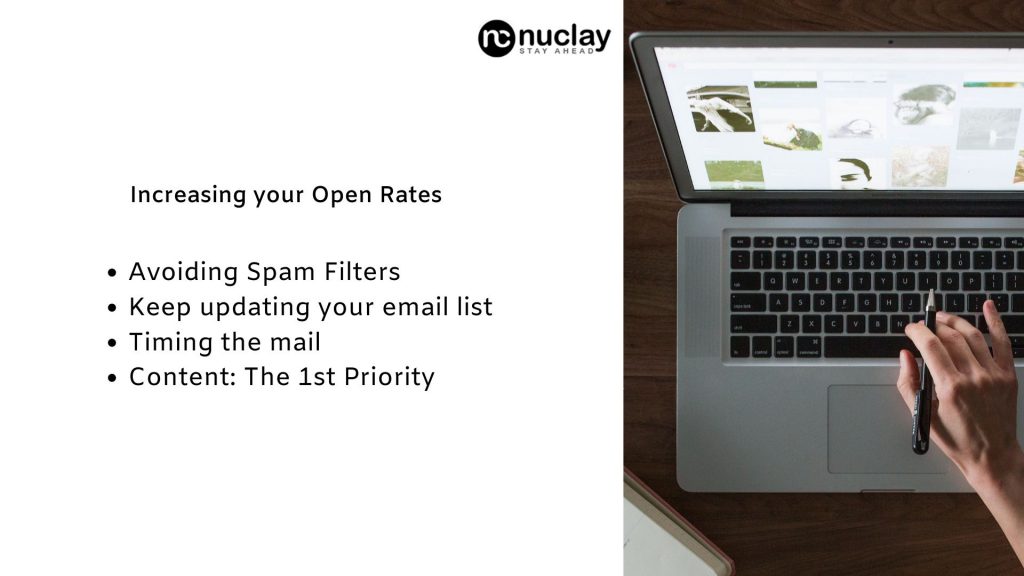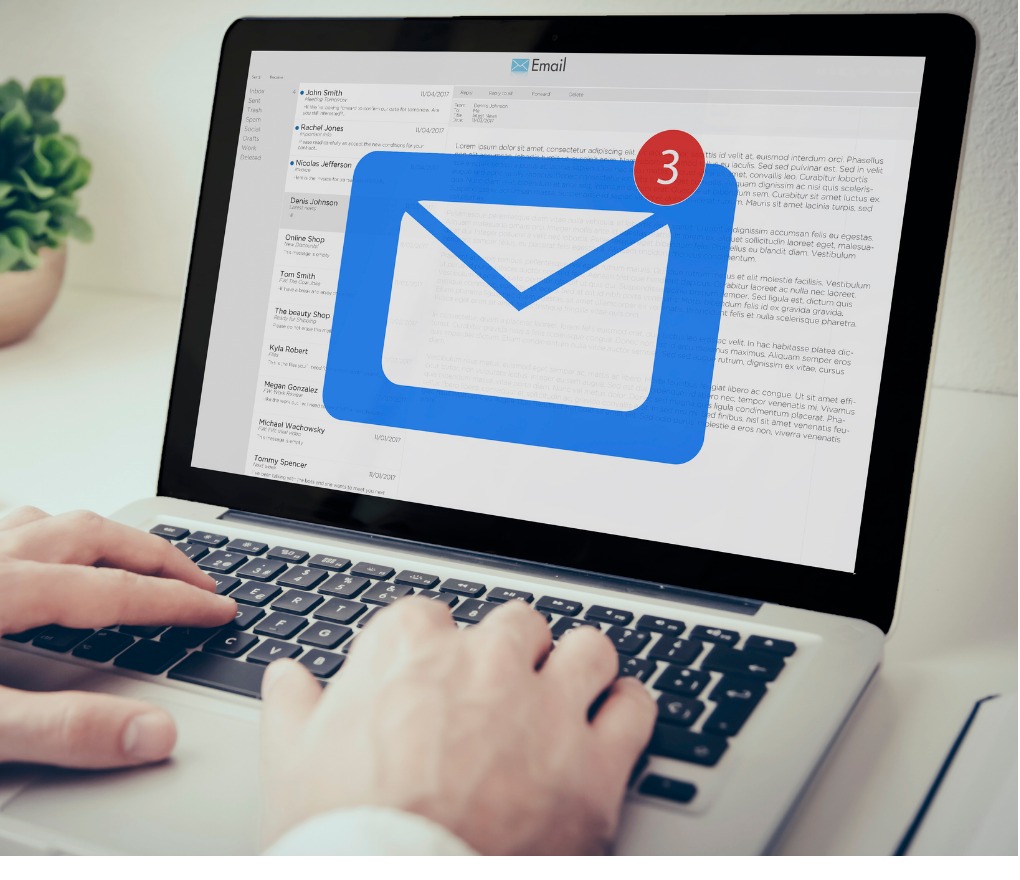“Old is gold”, yes it is. Even though artificial intelligence, chatbots and virtual reality are in their prime, but come what may, email has never lost its ground when it comes to digital marketing services. Why? Let us have a look.
Emails, when built carefully, are a direct entry for any marketeer into the minds of their audience. No need for any heavy algorithms or investment of money; just proper content and the right choice of emailing software could build you a lead or a potential customer. Moreover, it’s not just about marketing that makes ‘Email’ an integral part of customer orientation, but it is a major go-to tool to drive customer attention towards any product. They do not need to visit any blog or website. Just a little crisp gist about what you have to offer would do. Greater the driven attention greater the number of customers; the greater the number of customers, the bigger the business.
Want to know how Email could be your first step in growing your business? Here we present to you a beginner’s guide to Email Marketing.
Let’s Get Started
The first thing that you need to initiate is contacts, rather email lists. Remember, shortcuts are never a path to success, similarly we would never you to buy any contacts from third party organisations. Hence, we start with the most important thing, that is, the permission to email someone.
You shouldn’t email anyone until and unless you have the permission to mail them. This permission could be obtained through various channels, such as, getting an approval to receive mails by a square-button-tick at the end of a registration form in your company website. It depends on the user if he/she opts in or out of the service. There are numerous tools available over the internet that could help you build such opt-in forms. However, once you get the permission, you are eligible to make the user a part of your list.
Extending the contact-base
Even though opt-in forms are the first option that company’s use to build a contact-base, it is not that successful as not many people might end up opting the favourable. What do we do then? We use a compelling offer.
Lead Magnet
An offer, that doesn’t cost you anything neither the recipient, like as a legal bribe in exchange for an email address. Lead magnets could be anything ranging from a eBooks, PDFs, MP3 files, free trials, coupons, quizzes, etc, basically anything you want as long as it provides value to your visitors for free. A good magnet should be easily consumable, should be something useful or improving for the visitor and must be immediately available. If you serve a 300 page manifesto to the audience, obviously it won’t make you gain traction.
A good Opt-in Form
The basic motive behind your Opt-in form is to make your lead magnet appear beneficial, so that your visitors subscribe to whatever you offer.
The foremost step to build an effective Opt-in form is to give it an enticing headline and make sure it clearly describes the big benefit of your lead magnet. Then, add a brief description so that the user can get the clear idea even by skimming through it. Filling a form is like a conversation, hence try and make it attractive with graphics or a mock-up of the lead magnet. For example, a photo of a person pointing towards the opt-in form is one of the best ways to boost the interaction.
Once you are done with the form, you need to find a suitable place to fix it. Figuring out a suitable place is necessary so that the user finds it easier to access. (Some of the highest converting places to put your optin form here)
Noticeably, exit-popups have worked the best for making users subscribe to your website. These pop-ups show up exactly at the time when the user is about to leave your website. They mostly convert because when the user leaves your website, they mostly have read your content and might find it useful, hence, could end up subscribing to it. Moreover, they don’t hinder the reading experience as they are only triggered when the user is leaving.
Personalisation
Many would tell you to build a huge email list and get on with it. But our digital marketing solutions state otherwise. What we provide you with is a proper segmentation of your email list that offers effective marketing. Take a look how.
What is Email Segmentation?
What if you tell a person about offers related to water dispensers when they are looking for air conditioners? It is totally not useful information for them, isn’t it! Similarly, rather than broadcasting an email to an entire list of emails, send it to those who might really make use of the information provided.
Break down your subscribers into relevant groups based on specific criteria so that the emails that you send to them could be further personalised and contain relevant content.
What happens when you perform Segmentation?
First of all, relevant content attracts most. Hence, segmentation increases open rates, click rates, decreases your unsubscribe rates. That is why it is a smart move to market whilst employing segmentation to drastically improve your effective rates.
Segmentation also helps you organise the actions being taken by your subscribers. Did they fill a certain opt-in? Did they purchase a product? Visited a specific page? Downloaded a specific item?
Also, Segments make it so much easier to know what subject lines and messages to write that will entice the users to open and engage with your email campaigns.
Increasing your Open Rates
Here is the most important part : How to make the user open the email and engage with it!

It is why you put all your hard work. There are several factors influencing this. Let’s have a look at them one by one.
Avoiding Spam Filters
The first thing you don’t want happening with your email is that it ends up in the user’s spam folder. Since we already have the permission to send our subscribers mail and we have opted for a good email provider, we can make a good start.Anyway, make sure all of your recipients have opted in to receive the mails. Send your email campaign from a good IP address, that is, from an IP that hasn’t been used to spam in the past. It is also important to send email through verified domains and the email template code must be kept clean. Avoid the usage of ‘spam-triggers’ like “buy”, ”clearance” or ”discount”. Including your location is a great way of increasing the credibility of your emails. Lastly, include an easy way for subscribers to unsubscribe from your emails.
Keep updating your email list
It is necessary to remove the inactive users from your email lists to keep your list fresh. It depends entirely on you to set the interval for doing this, say 6 months. However, before you get rid of them, try sending a last ditch-effort mail to re-engage your inactive subscribers. Another way to keep your list fresh is by checking in with your subscribers every once in a while to ask if they would like to update their information and their preferences. This way, they are reminded that they can take control of how they want to engage with you.
Timing the mail
“Understanding the value of time.” Well, email marketing implements this quite literally. Have an insight at what time do your subscribers mostly use their emails. But how do you do this? It isn’t possible to immediately figure out the perfect time but performing some A/B tests to determine which timeframes seem to do best for your emails would be a great option for future campaigns.
Content: The 1st Priority
When it comes to content, it starts with the subject line. Your subject line is basically everything you need to improve your click rates. Subject lines need to entice curiosity in the mind of the subscribers. Use of friendly tone and humor is much appreciated. Also, numbers are a big eye-catcher too.
Address a single customer
When drafting your email, it is natural that you are drafting it for a large number of subscribers. But remember, the reader is singular when a subscriber opens the main. Hence, writing the mail in a tone that addresses just one person. For addressing different segments, you really need to be aware of the different buyer personas. Understand their problems, their desires, their likes/dislikes or even their values.
It is better to put your corporate hat on the side when writing an email to a subscriber. Write like you are addressing a friend, not a customer. In today’s age, everyone is looking to ignore mails. Adding a personal tone to your mails might catch attention rather than those filled with corporate catchphrases.
The content must obviously be great all the time. It isn’t like if the subscriber opens your email, your work is done. The content has a great influence on the subscriber’s mind in a way that if they like what you write to them, they will open your mails in the future as well. They may even begin to anticipate your mails after a point of time. Conversely, if they are displeased, they might opt out of receiving your mail entirely. The key to successful mails is not sending them just for the sake of sending them, but also delivering something of great value each time.
Lastly, it has become necessary to optimise the emails for mobiles.
According to a survey, more than 67% percent users use a smartphone to access their emails. Hence, mobile is of huge importance and simply cannot be ignored. Make sure your email is mobile friendly with responsive formatting and loadable media. Moreover, consider that mobile screens are smaller, so, longer subject lines won’t be properly viewable.
Autoresponders
The final step to creating a successful email marketing campaign. From the beginning, you have learnt how to grow your subscriber database, segregate them into effective groups, personalised the mails according to the same and optimised them for better results.
Now it is time to automate the process and turn your emails into money-making machines. The autoresponder is one of the most important tools for making sales. It helps you successfully engage with your email lists build relations and turn leads into buyers.
An autoresponder is a tool that sequences emails that are automatically sent to a segment of people on your email lists. This is triggered by an event, such as joining, browsing behavior, and the stages towards buying a product. They cater your leads by helping them in making better decisions through an automated onboarding process. They help you know the customer, build trust and draw their attention towards something they will like. Hence, it will be easier for you to pitch in at the right moment and convert prospects into customers. Creating an autoresponder includes the following steps:
Setting a goal
Mainly, the autoresponder could be used to send a welcome mail, entice the customer towards a lead magnet, send information about products which could result in inducing sales or up-sell/cross-sell products.
Outlining the Process
Draft an outline for the length of your process. There is no such rule about exactly how many mails you must have in your email sequence. It must be long enough to accomplish goals. So the length must depend on the purpose, segments, preferences, etc. Finding out the interval between two mails of the sequence is also necessary. Lastly, write an outline from the beginning to the end, describing what topic each mail would be covering and the call-to-action.
An Autoresponder that converts
Address the needs of your subscribers, offer ways to solve their problems, and keep in mind that it isn’t just about your products/services but the points/ struggles that your customers might face.
Subject lines
A subject line that doesn’t grab attention does not improve the open rate. So the majority of the time must be spent on polishing the subject line. A great subject line tempts you to know the content of the mail.
Monitor
As it goes on, it is necessary to monitor the responder and check for the updates wherever necessary. These changes could include subscriber preferences, further segmentation, improving what does not perform well, updating the information, etc.
That’s it. Here we present to you the basic guidelines to a successful email marketing campaign.



